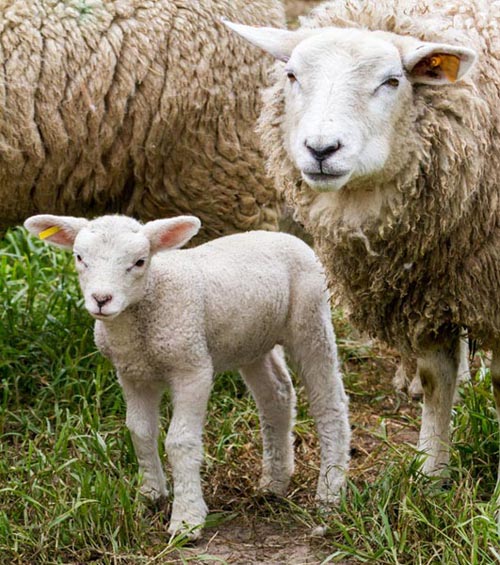The Benefits
In addition to it’s luxurious feel as a natural fiber, wool:
- is a natural flame retardant barrier – see the post ‘Interpreting the CA Flame Retardants Standard for Upholstered Furniture’ for more info.
- provides added protection for your latex foam cushion – from UV light that passes through the cover fabric.
- softens the edges of your upholstery cushion or padding.
- is a healthy & sustainable alternative to polyester batting.
Healthy Wool Practices
Wool is a very important part of natural upholstery, so in order to understand its value in the ‘big picture’, it pays to know the process that goes on behind the scenes to produce it.
Here at NaturalUpholstery.com we advocate the use of all natural, eco-friendly, non-toxic materials. When sourcing these products for our own use and for use by our customers, we pay careful attention to how they are produced. This is especially important with regard to wool and the treatment of the animals who grow it for us.

As you may know by now, wool comes from sheep ;) but it doesn’t end there. We believe the process should have a solid foundation of best practices regarding how the sheep are raised and cared for. Below are the wool growing criteria we look for when purchasing wool.
- PROPER GRAZING METHODS: Growers rotate sheep to different pastures to allow vegetation to recover from grazing. This practice minimizes invasive plant species while reducing the need to bring in outside feed. These proper grazing techniques reduce soil erosion, create higher quality wool, and reduce the risk of sheep acquiring internal parasites.
- HEALTHY VETERINARY PRACTICES: Only certain kinds of medications and supplements are permitted to treat the sheep. Alternative care methods are encouraged to keep sheep healthy with fewer chemicals. Generally, sheep raised in open pastures are healthier and require less veterinary care.

- CHEMICAL CONTROL: No herbicides or pesticides are used on fields where sheep will be grazing. Conscientious producers will perform random spot-testing to ensure the wool has never been in contact with harmful chemicals.
Steer Clear of these Wool Practices
Conscientious producers will firmly oppose the following wool-growing industry practices:
- CARBONIZING: Wool fibers are dipped in strong acids to dissolve residual vegetable matter.
- CHEMICAL CRIMPING: Carbonizing can leave wool fibers unnaturally straightened and the fibers then require a chemical “perm” to regain their coiled, crimped structure.
- DIPPING: At many farms all sheep are subject to a bath in a pesticide solution. Look for a more holistic approach.
- BLEACHING: In order to get the purest whites and brightest colors, most wool fibers are bleached and dyed. Look for wool batting that is the color of natural white wool.
- HARMFUL SHEARING: Look for producers that use highly skilled shearing crews to make this process as quick and harmless as possible.
- MULESING: Cutting patches of skin off sheep (to discourage infection and flies from laying eggs in the folds)… YIKES!!
- OVERGRAZING: In addition to harming the land, overgrazing lowers overall wool quality. More invasive plants begin to grow and can increase the amount of vegetable matter in the wool.
Wool Quality
Look for wool suppliers who proactive with their wool growers, ensuring the sheep are treated humanely. They should strongly discourage the use of pesticides or herbicides and should only accept wool with a vegetable matter content (debris in wool) of less than .05%. This means they start their process with exceedingly clean wool. Finally, the best wool comes from sheep that are treated with kindness.
Wool Batting Machinery
Here’s a photo of one supplier’s carding, combing & garneting process. They use unique antique machinery which removes more vegetable matter than most modern machinery, resulting in an exceptionally clean batting.

Imported or Domestic Wool?
Some imported wool batting comes from the most premiere wool growers in the world including South America, Australia, New Zealand and Europe. There are a few U.S. suppliers who source some or all of their raw material from growers who “have been hand-picked, meeting the highest standards of ethical practices that result in a high wool output”. Domestically produced wool batting most often follows the same high standards, with the added benefit of carrying a lighter carbon footprint. Purchasing domestically produced wool batting also supports smaller producers in the U.S.
Learn More
Watch the video below to see an example of handling one type of wool batting as it comes off the roll in our studio:
Learn more about how to use wool batting in your upholstery project in the video How to Measure your Natural Latex Cushion for Wool Batting, which includes a free worksheet to help you calculate how much wool you need. See also How to Cut your Wool Batting Book Wrap Style to minimize waste.
If you’re using latex foam for a new cushion you can also check out the video and worksheet How to Measure your Sofa Cushion for New Foam. If this is helpful for you, be sure to subscribe to NaturalUpholstery.com’s mailing list to learn more about natural upholstery materials, techniques, tools, and useful tips!
If I’ve left something out, please let me know in the comments below (others may have the same question, and this is the fastest way to get an answer! :)

I didn’t know these places existed!
What a great read! Thank you for sharing your insight on natural upholstery practices. We will surely be looking into ways to use natural upholstery techniques in the near future for our clients as well!